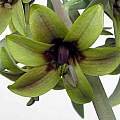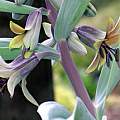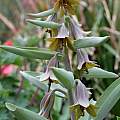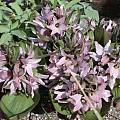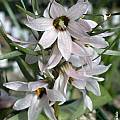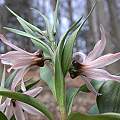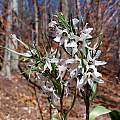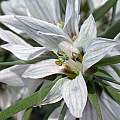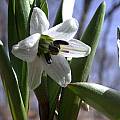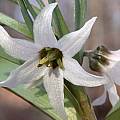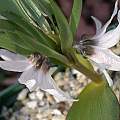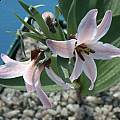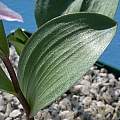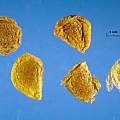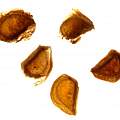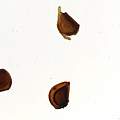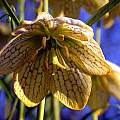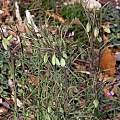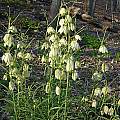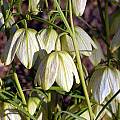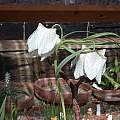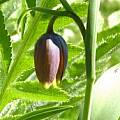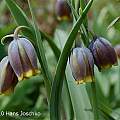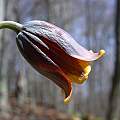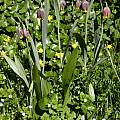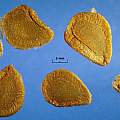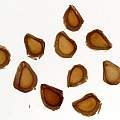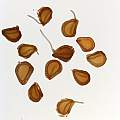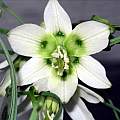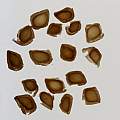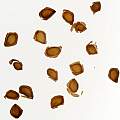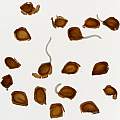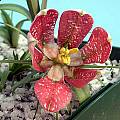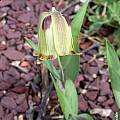Fritillaria that originate in Asia from s-z are described on this page. For information about other species consult the links below.
Asian fritillaria a-c - Asian fritillaria d-k - Asian fritillaria l-r - European fritillaria a-o - European fritillaria p-z - Fritillaria index - Miscellaneous fritillaria - North American fritillaria a-l - North American fritillaria m-z
Fritillaria sewerzowii Regel., syn. Korolkowia sewerzowii, is native to screes in the mountains of Kyrgyzstan, Kazakhstan, Afghanistan, N Pakistan and W China. It grows to 20-30 cm (8-12") and has pale greenish yellow flowers with rust to bitter chocolate centers with flowers colored purple brown to yellow on the back. Leaves are thick, lanceolate, glaucous and up to 4 cm (2") wide. Photos from Paige Woodward who notes this is hardy to Zone 6, possibly colder. She grows this species in cold frames and a roofed rock garden. In the rock garden, the bulbs have gradually worked themselves to the surface, weathering freeze-thaw-freeze and growing fatter each year.
Fritillaria sibthorpiana (Sm.) Baker from southwestern Turkey is one of several species from that general region with conical yellow flowers. The photo does not show its distinctive pair of large basal leaves. Shown flowering in a bulb frame in Oregon in late March; should not be dried out too much in summer. Height: 10 cm. Photo by Jane McGary.
Fritillaria stenanthera (Regel)Regel is an early-blooming Rhinopetalum section member from West to Central Asia. Typical plants have light pink flowers. Height: 15 cm. The image in photo 1 was taken by Jane McGary of a particularly deep pink form of this species and represents the increase of a single bulb grown from seed about ten years previously. It was grown in a bulb frame and kept dry in summer. Photos 2-6 were taken by John Lonsdale. Photos 5-6 are of a late pale form.
Fritillaria stenanthera 'Kazakhstan'
Fritillaria stenanthera 'Kyrgystan':
The first of these seed photos by David Pilling was taken using reflected light, the remainder with transmitted light. In photo 2 embryos are not visible; see Fritillaria Germination. Photo 3 taken 101 days later after the seeds had been exposed to cold (32-40 °F) and moisture shows germination is taking place.
Fritillaria thunbergii Miq. is native to China and Japan where it is found in scrub and light woods. It has linear leaves that are whorled on the top where there are also tendril-like tips. Flowers are cream-colored, flecked or tessellated green. This species needs to be planted deeply. Height: to 80 cm. Photos by John Lonsdale.
Fritillaria tortifolia X.Z.Duan & X.J.Zheng is native to China. The plant in the photo received from China and shipped by Paul Christian as F. ferganensis has now been identified as Fritillaria tortifolia. These flowers are very large, white with faint purple tessellation, and resemble those of Fritillaria pallidiflora in form. The tall stem required support. Height: to 100 cm. Photo by Jane McGary.
Fritillaria uva-vulpis Rix is native to Turkey, Iraq, and Iran where it is often found in fields. Height: 20 cm. The first photo from Jamie Vande is of the typical commercial form offered by most bulb houses. It likes sun and a well drained soil that is moist in the late winter and spring. The second photo is from Hans Joschko and the third photo from John Lonsdale. The last flower photo of the fox grape fritillaria was taken in the Montgomery County, Maryland, USA, USDA zone 7 garden of Jim McKenney who added his text. "This clump taught me a lesson: I forgot to dig it for the summer, and not only did the bulbs survive a wet summer, but the plants the next year were much bigger than those covered and kept dry for the summer. In the photo it is growing vigorously with Euroweeds Ranunculus ficaria and Veronica persica et al."
In these seed photos by David Pilling, the first was taken using reflected light and the remainder with transmitted light. In photo 2 embryos are barely visible; see Fritillaria Germination. Photo 3 taken 67 days later after the seeds had been exposed to cold (32-40 °F) and moisture shows the embryos have developed and germination is taking place.
Fritillaria verticillata Willdenow has been called by many names. The Kew checklist lists 18 taxa as synonyms. It is native from southern Siberia to Japan. Photo from Paige Woodward of a beautiful form that blooms abundantly in April, with up to six greenish-white bells on a 30-40 cm (12-16") stem. Its narrow leaves are tipped with tendrils to help it stand up in tall grass. Her plants descend from bulbs collected in the southern Altai Mountains where China and Kazakhstan meet. Being adapted to harsh conditions, it has done well in meager soil in sun to part shade and is drought-tolerant once established.
In seed photos (on a 10 mm grid) by David Pilling, the second is of the same seed as the first using transmitted light and does not show large embryos. The third photo was taken after 41 days of exposure to cold (32-40 °F) and moisture. The fourth was taken after a further 30 days, when the seed is germinating. See Fritillaria Germination.
Fritillaria walujewii Regel can be found in the Tien Shan mountain range and in central Asia. It has three bells of pinkish-purple that are tessellated. Narrow leaves are opposite or whorled at the top with tendrils at the tip. Height: to about 50 cm. Photo by John Lonsdale.
Fritillaria wendelboi (Rix) Teksen, syn. Fritillaria acmopetala ssp. wendelboi Rix is from southern Turkey and has flowers that are squared instead of rounded and fewer wider leaves. It is a short plant with green and maroon flowers topped by a darker purple band. Height: to about 20 cm.
Fritillaria zagrica Stapf in 2025 is considered to be a synonym of Fritillaria pinardii ssp. pinardii.
Asian fritillaria a-c - Asian fritillaria d-k - Asian fritillaria l-r - European fritillaria a-o - European fritillaria p-z - Fritillaria index - Miscellaneous fritillaria - North American fritillaria a-l - North American fritillaria m-z
